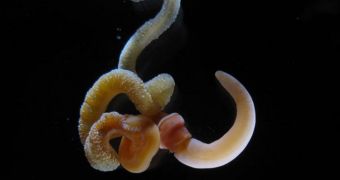The origins of the human brain may go way farther back in time than we first believed. According to the conclusions of a new study, the brains of humans and sea-dwelling worms share a genetic link.
Needless to say the two species separated from their last common ancestor millions of years ago, but traces that both come from the same primordial organism still endure. The new discovery has significant implications for the way scientists see our evolution.
They say that, in order to be able to see the bigger picture, we need to be prepared to cast a much wider net than before. This means taking into account scenarios that may seem irrelevant or unconnected to the issue at hand, at first.
For example, investigators did not analyze the potential link between worms and humans simply because the two species look nothing alike. Instead, they preferred to focus their attention on primates, dolphins, elephants and other higher animals (on the evolutionary scale).
The study was led by a joint team from the Stanford University and the University of Chicago. While analyzing the sea-dwelling, bottom-feeding acorn worm, Saccoglossus kowalevskii, researchers Chris Lowe and Ari Pani found essential genetic machinery once thought to belong exclusively to vertebrates.
The two are both biologists at the Stanford Hopkins Marine Station. They say that the discovery is remarkable because the creature does not display a vertebrate-like brain. In fact, they are separated from the latter by about 500 million years of evolution.
Details of the investigation were published in this week's issue of the top scientific journal Nature.
“The closer we looked, the more similarities we found between these strange worms and vertebrate brains in their underlying molecular blueprints,” explains Lowe, who is an assistant professor of biology.
“This suggests that essential parts of these blueprints, previously thought to be unique to complex brains, have much earlier evolutionary origins. No one thought hemichordates would be that informative in understanding the origin of vertebrates,” he adds.
The investigator concludes by saying that “these findings remind us that modern animals are all at the 'tips of the branches' of the evolutionary tree. And when we are searching for evidence about what our common ancestors were like, we have to look at all the branches to find the right clues.”

 14 DAY TRIAL //
14 DAY TRIAL //